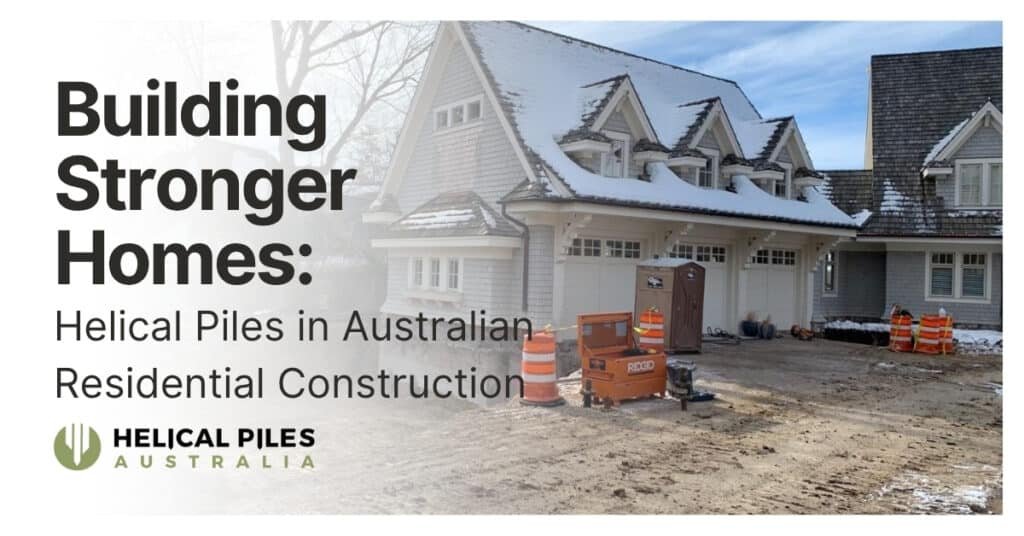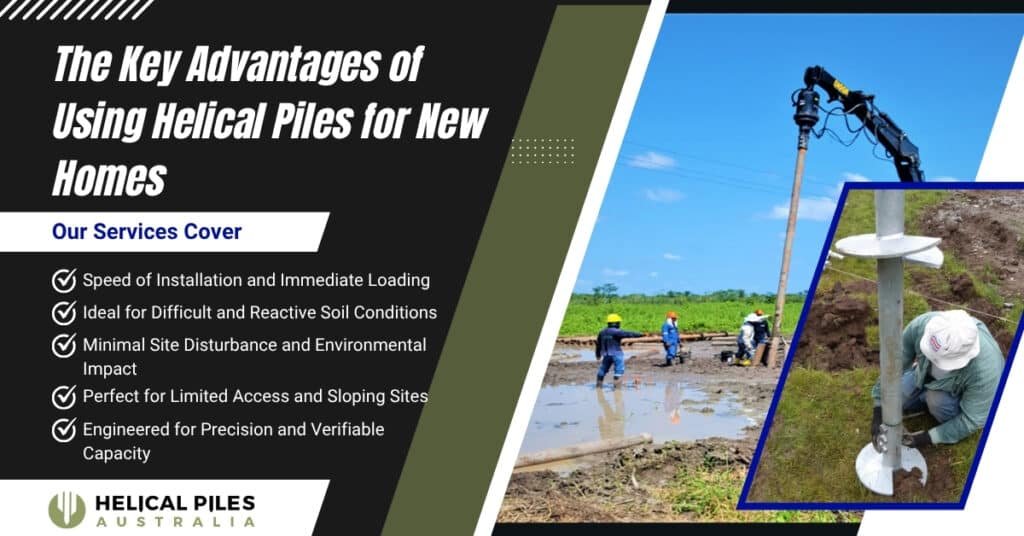ARTICLE
What Are Helical Piles and How Do They Work?

Building a home in Australia means dealing with some of the most diverse and challenging soil conditions in the world. From the shifting sands of coastal areas to the reactive clay that plagues suburbs in Adelaide and Melbourne, the ground beneath our feet can be unpredictable.
For decades, the standard response was to dig deeper and pour more concrete, a costly and time-consuming process. Today, a smarter, more efficient technology is changing the game. Helical piles, also known as screw piles, offer a modern, engineered solution for creating unshakeable house foundations in even the toughest ground.
Summary
- Helical piles are an engineered deep foundation system ideal for Australian residential construction, especially on sites with poor soil like reactive clay or sand.
- They offer significant advantages over traditional concrete foundations, including faster, vibration-free installation and immediate load-bearing capacity.
- The cost of helical piles is competitive with concrete, often providing savings through reduced excavation, spoil removal, and project timelines.
- They are a versatile solution for new home foundations, house extensions, and underpinning existing structures.
- Choosing helical piles ensures long-term structural stability and provides a reliable solution for challenging building conditions across Australia.
What Are Helical Piles and How Do They Work?
At its simplest, a helical pile is a large steel screw. It consists of a central, high-strength galvanised steel shaft with one or more helix-shaped plates welded to it. These helices are engineered to screw the pile into the ground with minimal soil displacement.
The installation process is what makes them so effective. Using a hydraulic drive head attached to an excavator or other specialised machinery, the pile is rotated and driven deep into the earth.
The installer continuously monitors the torque (the rotational force) required to advance the pile. This is the key: the torque reading directly correlates to the pile’s load-bearing capacity. The pile is screwed down until it either reaches a solid, load-bearing stratum of soil or rock, or it achieves a pre-determined torque specified by a geotechnical engineer.
This process provides a precisely engineered and instantly verifiable foundation, removing the guesswork often associated with traditional methods.
The Key Advantages of Using Helical Piles for New Homes
For homeowners and builders alike, the decision to use residential helical piles brings a host of powerful benefits that address the common pain points of traditional foundation work.
Speed of Installation and Immediate Loading
Traditional concrete foundations involve a lengthy multi-stage process: excavation, formwork construction, steel reinforcement placement, concrete pouring, and then waiting, which is often for days or even weeks, for the concrete to cure and gain enough strength to be built upon.
A typical helical pile installation in Australia can be completed in a fraction of that time, often in just a day or two. More importantly, as soon as the piles are installed, they are ready to bear their full load. This means your builder can start framing the very next day, dramatically accelerating the project timeline and reducing labour costs.
Ideal for Difficult and Reactive Soil Conditions
Many Australian homes are built on what is known as “reactive soil.” This type of clay soil swells when it gets wet and shrinks dramatically when it dries, exerting immense pressure on foundations and causing them to shift, crack, and fail over time. Screw piles for reactive clay soil are the perfect solution.
They bypass these unstable upper layers of soil, anchoring the structure deep into stable, non-reactive ground below the zone of seasonal moisture change. This effectively isolates the home from soil movement, preventing the common cosmetic and structural damage that plagues so many properties. The same principle applies to building on sand, silt, or uncontrolled fill.
Minimal Site Disturbance and Environmental Impact
Massive excavation is a hallmark of traditional foundation work. It creates a huge mess, generates tonnes of soil that must be transported and disposed of, and can damage the surrounding environment.
Helical pile installation is a clean, low-impact process. Because the piles screw into the ground, there is no large-scale soil removal. This not only saves on disposal costs but also preserves tree roots, existing landscaping, and neighbouring properties. It’s a more sustainable and less disruptive approach to building.
Perfect for Limited Access and Sloping Sites
Ever seen a concrete truck try to navigate a narrow inner-city laneway or a steep, sloping block? It’s often impossible. The machinery used to install helical piles is significantly smaller and more agile.
Excavators fitted with drive heads can easily access tight backyards for screw piles for house extensions, navigate between existing buildings, or work on difficult slopes where traditional methods would require expensive and extensive earthworks. This versatility opens up building possibilities on blocks previously considered too difficult or costly to develop.
Engineered for Precision and Verifiable Capacity
With a concrete footing, its ultimate strength can be variable and is only confirmed after it has cured. Helical piles offer engineered certainty. The relationship between installation torque and load capacity is well-documented and scientifically proven.
Throughout the installation of every single pile, the operator has a real-time readout of the torque being applied. This data confirms that each pile has met the load-bearing requirements set by the engineer, providing a level of quality assurance that is simply unmatched by conventional methods.

Helical Piles vs. Concrete Piers: A Cost and Performance Comparison
When planning a foundation, the obvious question is about the bottom line. While a head-to-head material comparison can be misleading, a holistic view often shows helical piles to be the smarter financial choice, especially when site conditions are less than perfect.
Analysing the True Cost of Helical Piles for a House Foundation
To understand the cost of helical piles for a house foundation, you must look beyond the price per pile. Consider the associated costs of a concrete alternative:
- Excavation: Labour and machinery costs to dig trenches or pier holes.
- Spoil Removal: Fees to transport and dispose of the excavated soil, which can be thousands of dollars.
- Formwork & Steel: Materials and labour to build forms and place rebar.
- Concrete & Pumping: The cost of the concrete itself, plus fees if a pump is needed for access.
- Weather Delays: Rain can halt excavation and pouring, pushing out timelines and increasing costs.
Helical piles for residential construction eliminate or drastically reduce most of these expenses, leading to significant overall project savings.
Is It Cheaper to Use Helical Piles or Concrete?
For a perfectly flat block with excellent soil conditions, a simple concrete slab might have a lower upfront cost. However, the moment you introduce any complexity, like reactive soil, a slope, poor access, or a high water table, the economic scales tip firmly in favour of helical piles.
The savings in time, reduced need for earthworks, and elimination of weather-related risks make them a more predictable and often more affordable solution for the majority of challenging Australian building sites.
Performance in Australian Climates
Australia’s climate of droughts and flooding rains wreaks havoc on reactive soils and the structures built on them. Shallow concrete foundations move with the soil, leading to cracked walls, sticking doors, and uneven floors. Because helical piles are anchored deep in stable ground, they provide a foundation that remains solid and stable regardless of the season. This long-term performance protects your investment and provides invaluable peace of mind.
Common Residential Applications for Helical Piles in Australia
The flexibility and reliability of helical piles make them suitable for a wide range of residential projects, from brand new builds to remedial work on existing homes.
New Home Foundations
For a new house construction project, a grid of helical piles can form the entire deep foundation system. Beams or a structural slab can then be built on top of the pile caps, creating a structure that is fully supported on stable ground from day one. This is the ultimate way to “future-proof” a home against foundation movement.
Foundations for House Extensions and Renovations
When adding an extension, the last thing you want is major disruption to your home and garden. The small footprint and minimal vibration of the installation equipment make screw piles the perfect choice.
They can be installed quickly and cleanly right beside the existing structure, providing a solid foundation for the new addition without undermining the original home.
Underpinning and Foundation Repair
If an existing home is sinking or has suffered structural damage due to foundation movement, helical piles are a leading solution for foundation repair. They can be installed strategically to lift and re-level the existing footings, transferring the building’s load onto the piles and permanently stabilising the structure.
Decks, Granny Flats, and Outbuildings
For smaller projects like decks, granny flats, carports, or sheds, helical piles offer a fast, simple, and robust foundation. They are far superior to digging holes and hand-mixing concrete, allowing you to build a strong base in hours, not days.
Summary On Residential Construction with Helical Piles
Helical piles represent a significant advancement in residential construction, offering a proven, engineered foundation solution for modern Australian homes. They provide a faster, more reliable, and often more economical alternative to traditional foundations, especially on the challenging sites common across the country.
By creating a stable base that is unaffected by problematic soils, helical piles ensure the long-term structural integrity and value of your property. For any new build, extension, or foundation repair project, considering helical piles is a smart investment in a secure and lasting foundation.
Frequently Asked Questions About Residential Helical Piles
How Long Do Helical Piles Last?
Properly installed, high-quality galvanised helical piles have a design life of over 100 years in many soil conditions. The heavy-duty galvanised coating protects the steel from corrosion, ensuring a very long-term and durable foundation for your home.
Are Helical Piles Cheaper Than Concrete?
While the upfront material cost can sometimes be similar, helical piles are often cheaper overall when you factor in the total project cost. Savings come from no excavation or spoil removal costs, reduced labour, a much faster construction schedule, and no risk of weather delays, making them a more cost-effective choice for many projects.
What Are The Disadvantages Of Helical Piles?
The main limitation of helical piles is that they may not be suitable for ground with very dense rock or large boulders close to the surface, which can obstruct the pile’s path. They also require specialised equipment and trained installers, meaning it’s not a DIY job. A geotechnical report is always necessary to ensure the ground is suitable.
Can You Build A House On Helical Piles?
Absolutely. Building a house on helical piles is a common and approved construction method in Australia. They are used to create deep foundation systems that support the entire load of a single or multi-storey home, providing exceptional stability, particularly on sites with poor soil.
How Deep Should A Helical Pile Be For A House?
The depth is determined entirely by the soil conditions on your specific site. A geotechnical engineer will specify the depth required to reach a stable, load-bearing soil stratum or to achieve the required torque (and therefore, load capacity). This could be as shallow as 3 metres or as deep as 15 metres or more.
Are Screw Piles Approved For Residential Construction In Australia?
Yes, screw piles (helical piles) are fully compliant with the National Construction Code (NCC) and Australian Standards. They are a widely accepted and increasingly preferred engineered foundation solution used by builders, engineers, and architects across every state and territory.
Need a quote or more info? Start here.
Contact Us
info@helicalpilesaustralia.com.au
+61 2 7251 9258
Mon–Fri, 8:00am–5:00pm AEST

Built for complexity.
Engineered for certainty.
A trusted partner for large-scale energy and infrastructure projects where precision isn’t optional, it’s mandatory
© 2025 Helical Piles Australia. All rights reserved.
Privacy Policy
Contact Us
info@helicalpilesaustralia.com.au
+61 2 7251 9258
Mon – Fri, 8:00am – 5:00pm AEST
Location
Ground Floor 3, 189 Kent St
Sydney, NSW 2000

